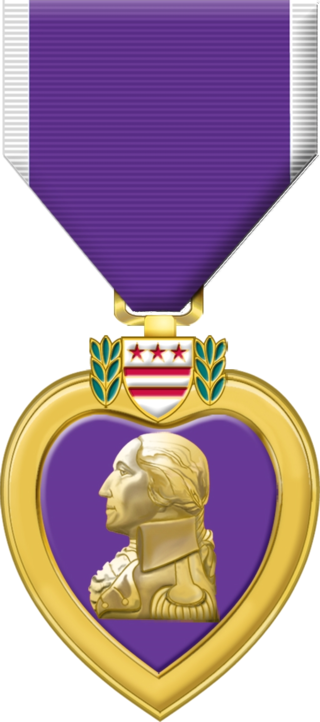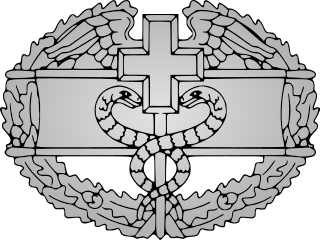
The Bronze Star Medal (BSM) is a United States Armed Forces decoration awarded to members of the United States Armed Forces for either heroic achievement, heroic service, meritorious achievement, or meritorious service in a combat zone.

The Purple Heart (PH) is a United States military decoration awarded in the name of the president to those wounded or killed while serving, on or after 5 April 1917, with the U.S. military. With its forerunner, the Badge of Military Merit, which took the form of a heart made of purple cloth, the Purple Heart is the oldest military award still given to U.S. military members. The National Purple Heart Hall of Honor is located in New Windsor, New York.

The 1st Infantry Division (1ID) is a combined arms division of the United States Army, and is the oldest continuously serving division in the Regular Army. It has seen continuous service since its organization in 1917 during World War I. It was officially nicknamed "The Big Red One" after its shoulder patch and is also nicknamed "The Fighting First." The division has also received troop monikers of "The Big Dead One" and "The Bloody First" as puns on the respective officially sanctioned nicknames. It is currently based at Fort Riley, Kansas.
The Combat Action Ribbon, is a United States Navy, United States Coast Guard, and United States Marine Corps military decoration awarded to United States sea service members "who have actively participated in ground or surface combat." Coast Guardsmen, Navy sailors, and Marines active in clandestine, stealth or special operations are deemed eligible for consideration of the award. The ribbon is awarded to members of the Navy and Marine Corps with a rank no higher than captain and colonel, respectively.

A marksman is a person who is skilled in precision shooting. In modern military usage this typically refers to the use of projectile weapons such as an accurized scoped long gun such as designated marksman rifle to shoot at high-value targets at longer-than-usual ranges.

The Combat Infantryman Badge (CIB) is a United States Army military decoration. The badge is awarded to infantrymen and Special Forces soldiers in the rank of colonel and below, who fought in active ground combat while assigned as members of either an Infantry or Special Forces unit of brigade size or smaller at any time after 6 December 1941. For those soldiers who are not members of an infantry, or Special Forces unit, the Combat Action Badge (CAB) is awarded instead. For soldiers with an MOS in the medical field they would, with the exception of a Special Forces Medical Sergeant (18D), receive the Combat Medical Badge. 18D Special Forces Medics would receive the Combat Infantryman badge instead.
The Expert Infantryman Badge (EIB) is a special skills badge of the United States Army.

The Special Forces Tab is a service school qualification tab of the United States Army, awarded to any soldier completing the Special Forces Qualification Course at the U.S. Army John F. Kennedy Special Warfare Center and School, Fort Bragg, North Carolina. Soldiers who are awarded the Special Forces Tab are authorized to wear it, as well as the green beret for the remainder of their military careers, even when not serving in a Special Forces command.
A "V" device is a metal 1⁄4-inch (6.4 mm) capital letter "V" with serifs which, when worn on certain decorations awarded by the United States Armed Forces, distinguishes a decoration awarded for combat valor or heroism from the same decoration being awarded for a member's actions under circumstances other than combat.

The Air Assault Badge is awarded by the U.S. Army for successful completion of the Air Assault School. The course includes three phases of instruction involving U.S. Army rotary wing aircraft: combat air assault operations; rigging and slingloading operations; and rappelling from a helicopter.

The Combat Medical Badge is an award of the United States Army which was first created in January 1945. Any member of the Army Medical Department, at the rank of colonel or below, who is assigned or attached to a ground combat arms unit of brigade or smaller size which provides medical support during any period in which the unit was engaged in ground combat is eligible for the CMB. According to the award criterion, the individual must be performing medical duties while simultaneously being engaged by the enemy; strict adherence to this requirement and its interpretation will vary by unit. As of 3 June 2005, Special Forces medics are no longer eligible for award, but may now receive the Combat Infantryman Badge. A revision has allowed aviation medics to be eligible for the CMB. The non-combat proficiency equivalent is the Expert Field Medical Badge.

In the United States (U.S.), a marksmanship badge is a U.S. military badge or a civilian badge which is awarded to personnel upon successful completion of a weapons qualification course or high achievement in an official marksmanship competition. The U.S. Army and the U.S. Marine Corps are the only military services that award marksmanship qualification badges. However, marksmanship medals and/or marksmanship ribbons are awarded by the U.S. Navy, U.S. Coast Guard, and U.S. Air Force for weapons qualifications. For non-military personnel, different U.S. law enforcement organizations and the National Rifle Association (NRA) award marksmanship qualification badges to those involved in law enforcement. Additionally, the Civilian Marksmanship Program (CMP) and the NRA award marksmanship qualification badges to U.S. civilians. Most of these organizations and the U.S. National Guard award marksmanship competition badges to the people they support who succeed in official competitions.

The Parachutist Badge, also commonly referred to as "Jump Wings", is a military badge of the United States Armed Forces. Some services, such as the Marine Corps, officially refer to it as an insignia instead of a badge. The United States Space Force and United States Coast Guard are the only branches that do not award the Parachutist Badge, but their members are authorized to receive the Parachutist Badges of other services in accordance with their prescribed requirements. The DoD military services are all awarded the same Military Parachutist Badge. The U.S. Army and U.S. Air Force issue the same Senior and Master Parachutist Badges while the U.S. Navy and U.S. Marine Corps issue the Navy and Marine Corps Parachutist Insignia to advanced parachutists. The majority of the services earn their Military Parachutist Badge through the U.S. Army Airborne School.
The Combat Recognition Ribbon was a tentative military award of the United States Army which was first proposed in the mid 1980s as an Army equivalent to the United States Navy’s Combat Action Ribbon.

Badges of the United States Army are military decorations issued by the United States Department of the Army to soldiers who achieve a variety of qualifications and accomplishments while serving on active and reserve duty in the United States Army.

The black beret is a colour of beret, a type of headgear. It is commonly worn by paramilitaries and militaries around the world, particularly armored forces such as the British Army's Royal Tank Regiment (RTR), the Royal Canadian Armoured Corps (RCAC), and Royal Australian Armoured Corps (RAAC) and the Indian Army Armoured Corps and Indian Border Security Force. Notable non-armored military units to wear the black beret include the non-military police and non-special forces elements of the Irish Defence Forces, MOD Guard Service, Russian Naval Infantry and Russian OMON units, the United States Air Force (USAF) Tactical Air Control Party (TACP), Philippine National Police-Special Action Force (PNP-SAF) members, and the Royal Canadian Navy. It was also worn by the United Kingdom's Royal Observer Corps (ROC) with their Royal Air Force (RAF) uniform, Metropolitan Manila Development Authority (MMDA).
Awards and decorations of the United States Army are those military awards including decorations which are issued to members of the United States Army under the authority of the Secretary of the Army. Together with military badges such awards provide an outward display of a service member's accomplishments.

Shoulder sleeve insignia (SSI) are distinctive cloth patches worn on the left sleeve of the United States Army uniform just below the shoulder seam by soldiers assigned to divisions, corps, armies, and other specifically authorized organizations. They are also worn on the right sleeve by soldiers to indicate former overseas service with certain units during periods of U.S. military operations in hostile conditions (MOHC).

Unofficial badges of the United States military are those badges or emblems that do not appear in United States military regulations but that many individuals serving in the United States military wear or display. Unofficial badges may also be bestowed for a one time action or be authorized under the authority of a local commander.

Cavalry Scout is the job title of someone who has achieved the military occupational specialty of 19D Armored Reconnaissance Specialist in the Combat Arms branch of the United States Army. As with all enlisted soldiers in the United States Cavalry, the person holding the Scout specialization will still be referred to as a "Trooper", the traditional colloquialism denoted in the cavalry's Order of the Spur.















